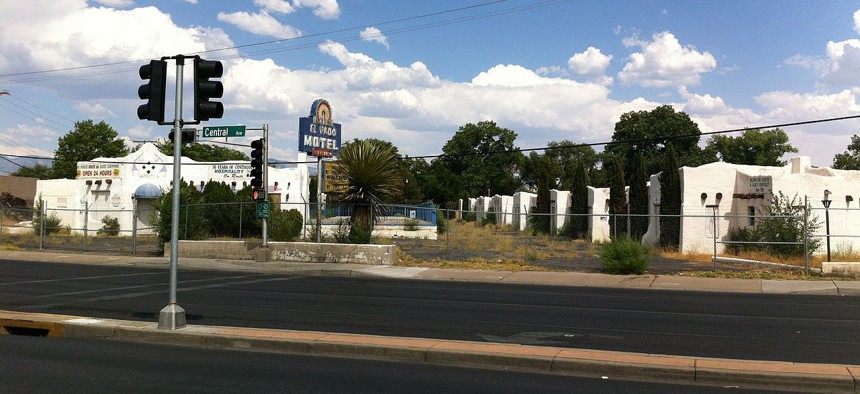Albuquerque Leverages P3 to Restore a ‘Special But Difficult’ Historic Route 66 Landmark

The El Vado Motel site in Albuquerque, New Mexico. Leonard J. DeFrancisci / Wikimedia Commons via CC BY-SA 3.0

Connecting state and local government leaders
America’s byways are dotted with boarded-up motels, but in New Mexico’s largest city, the old El Vado is set to be transformed through a public-private partnership.
A redevelopment site like the El Vado Motel, an abandoned landmark along historic Route 66 in Albuquerque, can be challenging. Across the nation, countless motor court motels from the mid-20th century sit abandoned, especially on roads that were bypassed by interstate highways.
I’ve seen plenty of them over the years, along the old Lincoln Highway in rural Nebraska and the Red Arrow Highway in southwest Michigan to the periphery of Breezewood, the infamous Pennsylvania highway junction once called “The Town of Motels.”
The Mother Road of America, as Route 66 is sometimes called, has many examples, too. But in New Mexico’s largest city, one vacant motel is set to see new life through a public-private partnership that Albuquerque’s leaders hope will not just revitalize a historic site but transform a part of their city in the process.
The historic El Vado Motel , located along a bend in Central Avenue west of downtown Albuquerque, opened in 1937 and is known for its Spanish Pueblo Revival architecture, has 32 units with covered carports, facing into a parking courtyard.
Places like the El Vado were popular with automobile tourists exploring the Southwest, but over time, fell into decline and disrepair. The El Vado, however, is on federal, state and city historic registries in part because it’s been largely unaltered and is among the best preserved pre-World War II motels along Route 66.
It’s been “a special but difficult historic site,” Suzanne Lubar, director of the Albuquerque Planning Department, said at a news conference with project stakeholders earlier this month regarding the forthcoming El Vado revitalization project.
The El Vado site was acquired by Albuquerque’s Metropolitan Redevelopment Agency about 12 years ago when the motel closed and since then, leaders in the city have been trying to figure out creative ways to redevelop the site while preserving the historic landmark.
At the Feb. 10 news conference, Albuquerque Mayor Richard Berry said the project has been a priority since he took office in 2009, but one that’s been a challenge for the city.
“It’s a testament to the fact that we love our historic buildings and these buildings are worth fighting for. And these neighborhoods are worth fighting for. And traditions are worth fighting for,” Berry said. “So it’s OK that it takes this long, as long as we get it done.”

Public-sector sources, including Albuquerque’s Family Housing Development Corp., are contributing $3.4 million in funding, while the remainder of the $18 million being spent on the project will be covered by private investment, led by Portland, Oregon-based Palindrome Communities.
“We’re about to see great things happen on this site,” Chad Rennaker, the president of Palindrome Communities, said, noting that he had driven by the El Vado site for years and his vision for the site predates Albuquerque issuing its request for proposals in 2014.
The revitalized El Vado property will include a boutique motel, event center, community food pods, tap room, spa pool and amphitheatre.
An adjacent property will be turned into multi-family market-rate housing as part of the site redevelopment.
“We’ve seen that when you do this type of infill housing, it really regenerates the entire neighborhood,” Rick Davis, executive director of the non-profit Family Housing Development Corp., said during the news conference.
It also fits in with the city’s forthcoming bus rapid transit project along Central Avenue . Berry said it’s “a fantastic bookend for the transit-oriented development” that’s taking shape in Albuquerque.
As more local governments turn to public-private partnerships to pursue development, infrastructure and other civic priorities, the El Vado project shows that there’s no quick and easy path forward. “It just takes a lot of patience and tenacity to get this done,” David said.
But as Berry said, they can be worth the wait.
“To be able to leverage that to save this great historic property and to create opportunity for people to live, to enjoy life, to enjoy this city that we live in,” Berry said. “It’s a good return on investment for the taxpayers.”
Michael Grass is Executive Editor of Government Executive’s Route Fifty and is based in Seattle.
Top photo by Leonard J. DeFrancisci / Wikimedia Commons via CC BY-SA 3.0,

NEXT STORY: How Many Hate Groups Does Your State Have?





